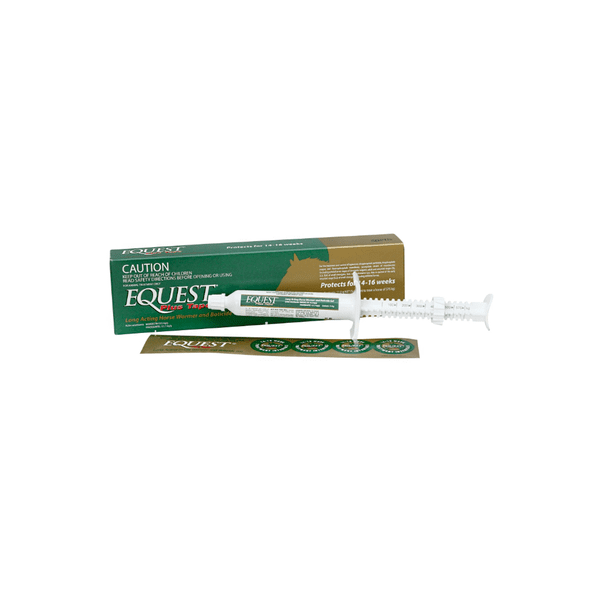EQUEST GEL PLUS
EQUEST GEL PLUS
Ingredients
Ingredients
Size Information
Size Information
Withholding Periods
Withholding Periods
Feeding Directions
Feeding Directions
Kit Includes
Kit Includes
Technical Data
Technical Data
Share
In stock
View full details


Product Description - all you need to know!
Equest® Plus Tape contains moxidectin and praziquantel, sufficient to treat a horse of up to 700 kg.
Controls tapeworm, bots and gastrointestinal roundworms including adult and encysted stages and benzimidazole resistant strains of small strongyles.
When used as directed, Equest Plus Tape Long Acting Horse Wormer & Boticide Gel is safe to use in foals over 4 weeks of age and in all breeding stock, including pregnant mares and breeding stallions.
Long acting: The Egg Reappearance Period (ERP) for Equest® Plus Tape is at least 14 weeks, which means that recontamination of the pasture by strongyle eggs is significantly reduced during this period.
Unique gel formulation that dissolves rapidly on the tongue, aiding compliance.
A dial-up syringe is designed with a narrow barrel to allow easy access into the side of the horse's mouth to deliver the right dose every time.
Recommendations for use:
Equest® Plus Tape is palatable and effective for the treatment and control of:
Tapeworm: Anoplocephala perfoliata, Anoplocephala magna and Paranoplocephala mamillana.
Large Strongyles: Strongylus vulgaris (adults, L3 and L4 arterial stages), Strongylus edentatus (adults and L4 visceral larval stages), Strongylus equinus (adults), Triodontophorus spp. (adults) including T. brevicauda,
T. serratus and T. tenuicollis, Craterostomum acuticaudatum (adults).
Small Strongyles (adults): Cyathostomum spp. including C. catinatum and C. pateratum; Cylicostephanus spp. including C. calicatus, C. goldi; C. longibursatus and C. minutus, Cylicocyclus spp. including C. brevicapsulatus,
C. elongatus, C. insigne, C. leptostomum, C. nassatus, C. radiatus, C. ashworthi and C. ultrajectinus; Cylicodontophorus bicoronatus; Coronocyclus spp. including C. coronatus, C. labiatus and C. labratus; Gyalocephalus capitatus; Parapoteriostomum mettami; Peterovinema poculatus; Poteriostomum imparidentatum, as well as benzimidazole resistant strains.
Pinworms: Oxyurus equi (adults and L3/L4 larval stages). Ascarids: Parascaris equorum (adults and intestinal stages (L4)). Hairworms: Trichostrongylus axei (adults).
Intestinal Threadworms: Strongyloides westeri.
Large Mouthed Stomach Worms: Habronema spp. ? gastric and cutaneous (summer sore) forms. Stomach Bots: Gasterophilus intestinalis (2 & 3 stage larvae), Gasterophilus nasalis (2 & 3 stage larvae). Cutaneous Onchocerciasis: Onchocerca spp. (microfiliariae).
Key Features
- Low dose volume.
- Lasts up to twice as long as other wormers, reducing labour and product costs.
- Palatable liquefying gel formulation means lower risk of wastage and consequent under-dosing.
- Equest® Plus Tape long acting horse wormer and boticide gel is the only horse wormer effective as a single dose against encysted stages of small strongyles: developing stages (DL), late encysted stages (LL3/EL4), and aids in control of early encysted stages (EL3) including inhibited larvae (greater than 90% effective).
 is here! Shop now, pay later in 4 easy installments
is here! Shop now, pay later in 4 easy installments

